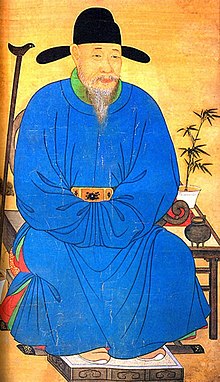|
Yeonguijeong
 The Yeonguijeong (Korean: 영의정; Korean pronunciation: [jʌŋ.ɰi.dʑʌŋ]) or Chief State Councilor was a member of the Uijeongbu and the highest government position in Joseon Korea.[1][2] The Yeonguijeong held roles similar to a modern-day prime minister of a presidential system.[3] As the senior member of the Chief State Council, the Yeonguijeong participated in the administration of general government affairs alongside the Jwauijeong and Uuijeong. The title was created in 1400 with the creation of the Uijeongbu. Existing for over 500 years, the function was handed over in 1895 during the Gabo Reform to the newly formed position of the Prime Minister of Korea.[4][3] Only one official, usually an elder who had previously served as Jwauijeong, was allowed to assume the position of Yeonguijeong. The Yeonguijeong was referred to as Yeongsang (영상; 領相; lit. leading minister of state), Sangsang (상상; 上相; lit. upper minister of state), Sugyu (수규; 首揆; lit. head premier) or Wonbo (원보; 元輔; lit. primary assistant).[3] Although the title of Yeonguijeong was legally defined as the highest post in charge of all state affairs, its practical roles and powers shifted drastically throughout history as the roles of the Uijeongbu were not clearly defined in the Gyeongguk daejeon. During the early years of Joseon, the Yeonguijeong saw limited roles in government as the Six Ministries reported directly to the king. HistoryEstablishmentUpon its founding in 1392, the state of Joseon initially inherited the state structure of its predecessor Goryeo (918–1392). In 1400, the second year of his reign, King Jeongjong reformed the Dopyeonguisasa (도평의사사; 都評議使司, also known as the Privy Council),[5] which was previously the supreme administrative body of the Goryeo dynasty, to the Uijeongbu. The head of the Uijeongbu was given the title "Yeonguijeong busa" (영의정부사; 領議政府事). As both functions of Uijeongbu got stronger, and its system was further revised, Yeonguijeong busa was renamed to Yeonguijeong in a firm establishment of the office.[3] In 1466, the position was officially put in statutory form with the finalization of the Gyeongguk daejeon.[6][7] The Yeongjuijeong title was generally conferred on a senior minister who had previously served as Jwauijeong (Left State Councilor),[8] a post immediately below that of Yeonguijeong, but higher than that of Uuijeong (Right State Councillor).[9] The three councilors were collectively known as the "Samjeongseung" (삼정승; 三政丞),[10] or "Samuijeong" (삼의정; 三議政; lit. Three High Councillors).[3] Changes in the roleUntil April 1436, the 18th year of Sejong the Great's reign, Jwauijeong and Uuijeong concurrently served as Panijosa (判吏曹事) and Panbyeongjosa (判兵曹事) respectively, so that they governed personnel affairs of yangban (the literary and military nobility). Yeonguijeong continued to exist as an honorary post, and so only managed to contemplate and adjust diplomatic documents or re-examine the cases of condemned people. However, when Hwang Hui was appointed as "Yeonguijeong busa" in that same year, Sejong modified the government system to strengthen the power of Samjeongseung from the Yukjo (Six Ministries) centered system. With the reform, Sejong noted that a situation in which three highest senior advisors could not participate in the state affairs contravened the original intention to have them as the high state councillors.[3] During the reform, Yukjo conferred with Uijeongbu regarding the responsibilities of each minister. Uijeongbu discussed legitimacy of the issues, and then reported to the king. After receiving an approval from the king, Uijeongbu returned to Yujo to enact the assigned affairs. As a result, Yeonguijeong came to participate more actively in the representative work as the head of Uijeongbu. However, other ministerial duities, such as the rights of Ijo (吏曹; Ministry of Personnel[11]) and Byeongjo (兵曹, Ministry of Military Affairs[12]) to implement personnel management, Byeongjo's mobilization of soldiers, Hyeongjo (刑曹, Ministry of Punishments[13])'s right to handle all criminals other than condemned people, were still directly operated by the related ministers.[3] When Prince Suyang usurped the place of his nephew, King Danjong, the function of Yeonguijeong was relegated to its previous powerless position. This was because when the King Sejo was still a prince, his actions were greatly restricted by his political rivals, Yeonguijeong, Hwangbo In and Jwauijeong, Kim Chongsŏ. So during the reigns of King Seongjong and Jungjong, there were several proposals to restore the former powers of Uijeongbu, but those suggestions were not implemented.[3] Major affairs of the state were discussed when Bibyeonsa was established in 1558 (during the 10th year of King Myeongjong's reign). The three High Councillors attended meetings only as "Dojejo" (Supreme Commissioner[14][15]). So the power of Yeonguijeong tended to be increased or decreased, depending on the political atmosphere of the times, such as the degree of the king's power, the relationship between Uijeongbu and Yukjo, the establishment of Bibyeonsa (備邊司; Border Defense Command[16]), the later administration of Kyujanggak (the Royal Library), the conflicts between political parties, and the advancement of "in-law government" (勢道政治, Sedo jeongchi[17]), among others. Regardless, the title "Yeonguijeong" continued as the apex in the bureaucratic system throughout the entire Joseon period.[3] List of Joseon Yeonguijeong
See alsoReferences
|
|||||||||||||||||||||||||||||||||||||||||||||||||||||||||||||||||||||||||||||||||||||||||||||||||||||||||||||||||||||||||||||||||||||||||||||||||||||||||||||||||||||||||||||||||||||||||||||||||||||||||||||||||||||||||||||||||||||||||||||||||||||||||||||||||||||||||||||||||||||||||||||||||||||||||||||||||||||||||||||||||||||||||||||||||||||||||||||||||||||||||||||||||||||||||||||||||||||||||||||||||||||||||||||||||||||||||||||||||||||||||||||||||||||||||||||||||||||||||||||||||||||||||||||||||||||||||||||||||||||||||||||||||||||||||||||||||||||||||||||||||||||||||||||||||||||||||||||||||||||||||||||||||||||||||||||||||||||||||||||||||||||||||||||||||||||||||||||||||||||||||||||||||||||||||||||||||||||||||||||||||||||||||||||||||||||||||||||||||||||||||||||||||||||||||||||||||||||||||||||||||||||||||||||||||||||||||||||||||||||||||||||||||||||||||||||||||||||||||||||||||||||||||||||||||||||||||||||||||||||||||||||||||||||||||||||||||||||||||||||||||||||||||||||||||||||||||||||||||||||||
